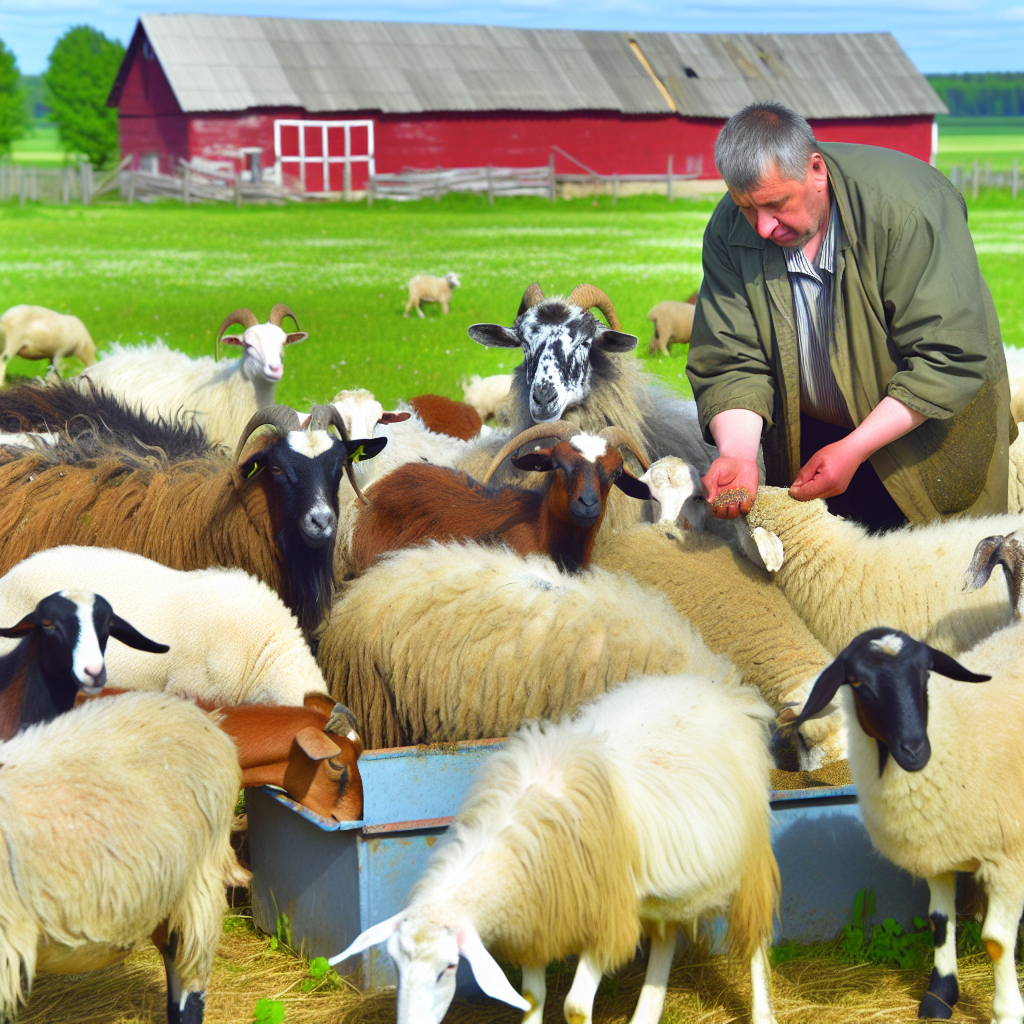Understanding the Seasonal Needs of Sheep and Goats
Spring Care Tips
Spring is a time of renewal for sheep and goats.
They require more nutritional support during this period.
Fresh grass and legumes should be available for grazing.
Check for signs of parasites after the winter months.
Vaccinate animals as needed to prevent disease outbreaks.
Shearing often occurs in spring to improve comfort.
Summer Care Tips
Summer brings heat, demanding extra attention to hydration.
Ensure fresh water is accessible at all times.
Shade is crucial to protect animals from heat stress.
Monitor for flies and other pests during this season.
Consider using fly deterrents for comfort.
Ration feed to prevent overeating during cooler evenings.
Fall Care Tips
In fall, prepare for the impending winter months.
Ensure that nutritional needs are met with high-quality hay.
Evaluate shelters for necessary repairs or improvements.
Transform Your Agribusiness
Unlock your farm's potential with expert advice tailored to your needs. Get actionable steps that drive real results.
Get StartedStart transitioning to heavier coats with adequate feeding.
Check fencing for fall storms and potential breaches.
Winter Care Tips
Winter poses unique challenges for sheep and goats.
Provide ample bedding to protect against the cold.
Regularly check water sources to prevent freezing.
Feed high-energy supplements to maintain body heat.
Limit outdoor exposure during harsh weather conditions.
Keep an eye on body weight as an indicator of health.
Key Differences in Care Requirements Between Sheep and Goats by Season
Spring Care Requirements
Spring is a vital time for both sheep and goats.
Sheep require shearing to prepare for warmer weather.
They benefit from pastures rich in nutrients as grass grows.
Goats, on the other hand, enjoy browsing on new foliage.
This season is also a good time to check their health.
Vaccinations should be administered if needed.
Additionally, observe for parasites that thrive in spring.
Summer Management Practices
Summer brings heat, impacting care routines.
Sheep are prone to heat stress; provide plenty of shade.
Ensure access to fresh, clean water at all times.
Goats are more resilient but still need cooling options.
Monitor their behavior for signs of overheating.
Sheep require regular hoof trimming during this time.
Goats may also need hoof care, especially if they are housed in wet areas.
Autumn Adjustments
As autumn approaches, prepare for changing temperatures.
Begin planning for winter housing and bedding.
Showcase Your Farming Business
Publish your professional farming services profile on our blog for a one-time fee of $200 and reach a dedicated audience of farmers and agribusiness owners.
Publish Your ProfileSheep will start to gain weight for winter survival.
Transition them to a nutrient-dense diet as needed.
Goats should also be fed more as their activity decreases.
Monitor both species for signs of illness as weather changes.
Winter Care Essentials
Winter poses unique challenges for both sheep and goats.
Sheep need a dry shelter to protect them from cold winds.
Proper bedding is crucial for maintaining warmth.
Goats require similar shelter requirements.
Check hay supplies regularly to ensure nutritious feed.
Keep them free from ice and snow in their feeding areas.
Health checks should continue throughout winter months.
Nutrition Adjustments for Sheep and Goats in Winter
Understanding Winter Nutrition Needs
Winter brings unique challenges to sheep and goats.
These animals require specific nutritional adjustments during colder months.
Understanding their needs is crucial for maintaining health and productivity.
Increased Energy Requirements
Cold weather increases energy requirements for sheep and goats.
They expend more energy to maintain body heat.
Feed them high-energy diets to meet these demands.
Consider adding more grains and energy-dense feeds.
Choosing the Right Feeds
Select feeds high in fats and carbohydrates.
Options include corn and soybean meal.
These will provide the necessary energy boost.
Ensure Adequate Fiber Intake
Fiber is essential for digestive health, even in winter.
Hay quality becomes crucial as pasture growth slows down.
Provide good quality hay to meet fiber needs.
Monitoring Hay Quality
Test hay for nutritional content before feeding.
Look for signs of spoilage or mold.
Using high-quality hay boosts overall health and digestion.
Supplementation for Balanced Nutrition
Consider supplements to enhance winter nutrition.
Mineral and vitamin supplements can prevent deficiencies.
Focus on calcium, phosphorus, and vitamin E levels.
Consulting a Nutritionist
Engaging a livestock nutritionist offers tailored recommendations.
They can help craft specific diets based on individual needs.
Hydration Matters in Cold Weather
Provide access to fresh, unfrozen water daily.
Hydration improves feed digestibility and overall health.
Consider heated waterers to prevent freezing.
Observation and Monitoring
Regularly observe sheep and goats for signs of health issues.
Poor body condition or unusual behavior may indicate nutritional problems.
Adjustment of diet based on these observations is essential.
See Related Content: Improving Livestock Productivity through Genetics
Summer Heat Stress Management Strategies for Sheep and Goats
Understanding Heat Stress
Heat stress poses a serious threat to sheep and goats during summer.
Showcase Your Farming Business
Publish your professional farming services profile on our blog for a one-time fee of $200 and reach a dedicated audience of farmers and agribusiness owners.
Publish Your ProfileIt can lead to decreased performance and even health complications.
Recognizing the signs of heat stress is crucial for effective management.
Symptoms include excessive panting, drooling, and lack of appetite.
Providing Adequate Shade
Shade is essential for livestock during intense heat.
Ensure they have access to shaded areas at all times.
Natural shade from trees is beneficial, but artificial structures work too.
Use tarps or shade cloths to create additional covered spaces.
Ensuring Fresh Water Supply
Hydration is vital for preventing heat-related issues.
Provide clean and cool water continuously throughout the day.
Consider using troughs or buckets that are insulated to keep the water cool.
Regularly check water sources to avoid contamination and algae growth.
Adjusting Feeding Practices
Modify feeding schedules to avoid the hottest parts of the day.
Offer lighter meals during the afternoon, focusing on high-energy feeds.
Use feed additives that can help manage heat stress.
Incorporate wet feeds or spoiling techniques to increase moisture intake.
Monitoring Health Closely
Keep a close eye on your flock’s well-being during high temperatures.
Regularly check for signs of heat stress and dehydration.
Consult a veterinarian if any animals show severe distress.
Routine health assessments can prevent serious issues before they escalate.
Utilizing Cooling Techniques
Implement various cooling methods to assist your livestock.
Sprinklers or misters can help lower the ambient temperature.
Fans can also provide additional airflow in enclosed areas.
Ensure that any cooling methods do not create muddy or slippery conditions.
Planning for Seasonal Changes
Anticipate changes in temperature and plan accordingly.
Implement strategies in advance of high-temperature forecasts.
Keep abreast of upcoming weather conditions to react promptly.
Adapt your management practices as needed throughout the season.
Explore Further: Genetic Tools for Enhancing Dairy Production
Spring Management Practices for Sheep and Goats
Shearing Considerations
Shearing is an important spring practice for sheep management.
This process removes excess fleece and promotes better health.
First, evaluate the fleece condition in early spring.
Look for signs of matting or dirt accumulation.
Next, choose the right shearing time, typically before lambing season.
Shearing too late can stress the animals.
Additionally, ensure your shearing equipment is properly maintained.
Utilizing sharp blades can enhance the shearing process.
This practice minimizes discomfort for the sheep.
After shearing, provide adequate shelter from harsh weather.
Monitor the animals closely for any signs of stress.
Breeding Considerations
Spring is a crucial time for breeding management in sheep and goats.
Showcase Your Farming Business
Publish your professional farming services profile on our blog for a one-time fee of $200 and reach a dedicated audience of farmers and agribusiness owners.
Publish Your ProfileEarly spring allows for optimal breeding conditions.
Ensure your breeding stock is in good condition and healthy.
Monitor their body condition scores regularly.
Use good genetics for both sheep and goats to improve offspring quality.
Consider using a controlled breeding schedule for efficiency.
This method helps ensure synchronized lambing or kidding.
Also, check for any necessary vaccinations before breeding.
Vaccinated animals generally have better reproductive success.
Finally, address any environmental changes to support healthy breeding.
These changes include improving grazing areas and water availability.
See Related Content: Essential Tips for Exotic Livestock Care

Fall Preparation
Health Checks
Conducting health checks is vital before winter arrives.
Start by inspecting sheep and goats for any signs of illness.
Look for symptoms such as coughing, nasal discharge, and lethargy.
Next, consult your veterinarian for vaccinations.
Ensure that all necessary vaccinations are up to date.
Additionally, check their body condition scores.
Adjust feeding strategies to help maintain a healthy weight.
Remember to check for parasites, as they can hinder health.
Perform fecal testing to determine parasite load.
If necessary, administer dewormers as per the vet’s advice.
Feeding Strategies
Feeding strategies play a crucial role in winter preparation.
Start by assessing the nutritional needs of your flock.
Increase energy intake during colder months.
Consider providing hay or silage as supplemental feed.
Choose high-quality forage to ensure optimal nutrition.
Also, provide mineral supplements tailored for sheep and goats.
Ensure access to fresh, clean water at all times.
Monitor their food intake and adjust as necessary.
Incorporate grain or concentrates for additional energy.
Creating a Cozy Environment
Providing a warm environment is essential for your livestock.
Ensure that shelter is windproof and dry.
Check for leaks and repair any damaged structures.
Use bedding materials like straw or wood shavings for warmth.
Additionally, separate sick animals to prevent spread of disease.
Organize feeding and watering areas inside the shelter.
This arrangement will protect your animals from harsh conditions.
Regular cleaning is also crucial to maintaining a healthy environment.
See Related Content: Optimizing Livestock Transport for Farm Efficiency
Implementing a Parasite Management Plan Throughout the Seasons
Understanding Parasite Lifecycle
Parasites thrive in specific environmental conditions.
Showcase Your Farming Business
Publish your professional farming services profile on our blog for a one-time fee of $200 and reach a dedicated audience of farmers and agribusiness owners.
Publish Your ProfileUnderstanding their lifecycle helps in effective management.
They often reproduce rapidly in warm and moist conditions.
Monitoring weather patterns can predict parasite outbreaks.
Regular assessments of livestock can help detect issues early.
Seasonal Monitoring Techniques
Throughout the year, monitoring should adapt to seasonal changes.
In spring, inspect for signs of increased lice or mites.
Summer months often bring higher heat stress and parasite activity.
Cooler fall temperatures can lead to a resurgence in certain parasites.
Winter inspections focus on internal parasites due to reduced grazing.
Integrating Pasture Management
Effective pasture management reduces parasite load significantly.
Rotate grazing areas to minimize parasite exposure.
This leads to healthier grazing habits among livestock.
Keep pastures well-drained to reduce moist environments.
Overseeding with resistant plant species can also help.
Utilizing Strategic Deworming
Implement a deworming strategy tailored to seasonal needs.
Begin deworming protocols based on regional parasite prevalence.
Consult with a veterinarian to schedule appropriate treatments.
Use a variety of dewormers to prevent resistance.
Follow up with fecal tests to gauge effectiveness.
Educating Staff and Producers
Training is vital for effective parasite management.
Educate farm staff about parasite identification and lifecycle.
Regular meetings can reinforce best practices and strategies.
Provide updates on emerging threats and new treatments.
Encourage reports of unusual signs or increasing parasite loads.
Providing Adequate Shelter and Bedding for Seasonal Weather Changes
Importance of Proper Shelter
Proper shelter is essential for sheep and goats during seasonal weather changes.
It protects them from harsh conditions like rain, snow, and extreme heat.
A well-designed barn or shed ensures their comfort and health.
Additionally, it helps prevent stress and illness in livestock.
Choosing the Right Location
Choosing an appropriate location for shelter is crucial.
Consider areas with good drainage to avoid flooding.
Also, select a spot that offers protection from prevailing winds.
Moreover, accessibility for feeding and cleaning is important.
Shelter Design Considerations
The design of the shelter should prioritize ventilation.
Good airflow reduces moisture and minimizes respiratory issues.
Also, include adequate space to avoid overcrowding.
Ensure that the shelter has solid walls and a waterproof roof.
Bedding Options for Comfort
Providing proper bedding helps keep animals warm and dry.
Straw, hay, and wood shavings are excellent bedding materials.
Regularly clean and replace bedding to prevent disease.
Wet or soiled bedding can lead to health issues.
Showcase Your Farming Business
Publish your professional farming services profile on our blog for a one-time fee of $200 and reach a dedicated audience of farmers and agribusiness owners.
Publish Your ProfileAdjusting Shelter for Seasonal Needs
Adjust the shelter setup according to the season.
In winter, make sure it’s well-insulated and draft-free.
During hot summer months, provide shade and cooling options.
Consider adding fans or misting systems when necessary.
Regular Maintenance of Shelter
Regular maintenance is vital for shelter longevity.
Inspect for any damage before every season begins.
Repair leaks, replace old roofing, and ensure door mechanisms work.
Keeping the shelter clean prevents pests and disease outbreaks.




